The Son of Tempurung
Reproduced from The Star Online: Adventure
Story and pictures by Chan Ah Lak.
Click on thumbnail for a larger picture.
| Gua Tempurung near Gopeng, Perak is the largest cave system in Peninsular
Malaysia. Lights, boardwalks and staircases have all been installed so
that the caves are now easily accessible to casual visitors. For
the more adventurous, however, there’s always a nearby and lesser known
cave system, Anak Tempurung.
This "Son of Tempurung" is literally in the shadow of its "mother."
Recently, the Caving Coordinator of the Malaysian Nature Society (Perak
Branch), Chang Kok Ai, led a group of 42 members to this rear appen-dage
of Gua Tempurung. Entry was via a small stream running through a narrow
and low passage. Initially we had to do quite a bit of duck-walking and
stooping, and this drew protests from those with weak knees and backs.
Except for a short stretch where crawling on all four – and even on our
bellies – was required, progress was not too unpleasant.
|
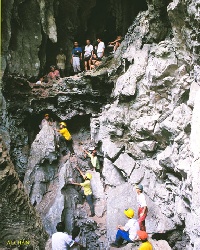
Entrance to AnakTempurung |
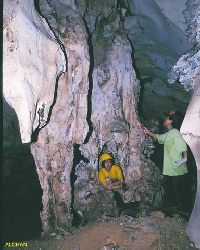
Iris Kok and Yoon admirng formation |
The sloshing water at our feet, the darkness and the featureless walls
made us feel like we were walking through a sewage tunnel. The only
difference was that this tunnel had many more twists and turns. After about
200m, we came upon a shower of water cascading down from the ceiling. We
had reached the end of the passage.
Here we decided to linger a little. After a short break for refreshments,
the group commenced climbing into a dry 80m passage. The steep climb ended
in a narrow opening overlooking the North–South Ex-pressway. We took a
breather and then continued making for our final destination. Inching along
a narrow ledge at one point, we found ourselves at times spread-eagled
against the face of the rock wall. |
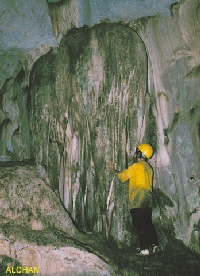
Algae encrusted'Jellyfish' in upper chamber |
But before we knew it, we had stumbled upon the yawning entrance to
Anak Tempurung. Climbing to the entrance of Anak Tem-purung proved tricky
as an overhang prevented us from reaching it. The only way was to climb
to a small chamber directly below it and squeeze through a hole there.
In order to reach this chamber, we had to scale a vertical rock. And to
make life a little more difficult, there was a limestone saddle in front
of the chamber. To negotiate this obstacle, we had to swing our legs astride
the broad saddle and sort of slide down onto the other side.
| "Just like riding a horse" quipped Chang as he waited patiently in
the chamber to guide us up. The hole that opened into the floor of the
entrance is the size and shape of a toilet bowl. Two experienced cavers,
Michael Liew and Ong Boo Kuan, who went up earlier, had a busy time
playing "midwife" to subsequent cavers coming through. Not relishing this
bit of challenge, about half the group decided not to make this difficult
climb down. They thought it would be safer to sit outside the cave and
enjoy the scenery. The brave ones who successfully made it into the upper
cave were welcomed by some interesting rock formations. After a couple
of s-bends and a climb up a slippery ramp, the passage opened into a chamber
about 20m in diameter and 5m high. A small skylight illuminated the chamber,
home to about a hundred bats. A 4m high flowstone in the shape of a jellyfish
presented a rewarding find. |
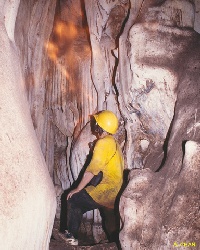
White flowstones |
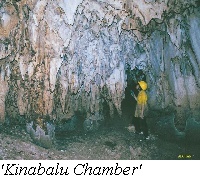 We found
that the dim lighting had promoted the growth of algae, giving this rocky
monument an interesting greenish hue. Several pure white flowstones in
the darker recesses of the chamber enticed the cavers to linger a few moments
longer. As we retraced our steps out, we decided to explore another
side of the chamber, nicknamed "Kinabalu Chamber." It was about 6m in diameter.
On one end of the floor, there was a limestone formation that looked like
the two famous peaks of Mount Kina-balu – the South Peak and Low’s Peak.
Walking around them gave us the sensation of being in a plane, flying over
Mount Kina-balu. It had been aptly named. On the roof at the other end
of this chamber were numerous limestone curtains, reminiscent of the blades
of a guillotine. In the centre of the chamber was a mire of soft white
mud. One unwary caver sank into it, right up to his knees.
We found
that the dim lighting had promoted the growth of algae, giving this rocky
monument an interesting greenish hue. Several pure white flowstones in
the darker recesses of the chamber enticed the cavers to linger a few moments
longer. As we retraced our steps out, we decided to explore another
side of the chamber, nicknamed "Kinabalu Chamber." It was about 6m in diameter.
On one end of the floor, there was a limestone formation that looked like
the two famous peaks of Mount Kina-balu – the South Peak and Low’s Peak.
Walking around them gave us the sensation of being in a plane, flying over
Mount Kina-balu. It had been aptly named. On the roof at the other end
of this chamber were numerous limestone curtains, reminiscent of the blades
of a guillotine. In the centre of the chamber was a mire of soft white
mud. One unwary caver sank into it, right up to his knees.
Later in the day, the group made their way home using a different route.
We climbed down the steep slope from the cave entrance directly to
the base of the hill where pre-viously we had negotiated a labyrinth
of tunnels and narrow caves.
Cave exploration can be dangerous without proper equipment and
guidance. Those who are interested in nature ap-preciation trips like caving,
bird watching, hiking, camping and marine outings, contact:
Malaysia Nature Society, Perak Branch
Ipoh Garden Post Office Box 34,
31407 Ipoh, Perak
Webpage: http://members.fortunecity.com/mnsperak
E-mail:[email protected]
Created on 16 Oct 2001
Back to MNS Perak Home




 We found
that the dim lighting had promoted the growth of algae, giving this rocky
monument an interesting greenish hue. Several pure white flowstones in
the darker recesses of the chamber enticed the cavers to linger a few moments
longer. As we retraced our steps out, we decided to explore another
side of the chamber, nicknamed "Kinabalu Chamber." It was about 6m in diameter.
On one end of the floor, there was a limestone formation that looked like
the two famous peaks of Mount Kina-balu – the South Peak and Low’s Peak.
Walking around them gave us the sensation of being in a plane, flying over
Mount Kina-balu. It had been aptly named. On the roof at the other end
of this chamber were numerous limestone curtains, reminiscent of the blades
of a guillotine. In the centre of the chamber was a mire of soft white
mud. One unwary caver sank into it, right up to his knees.
We found
that the dim lighting had promoted the growth of algae, giving this rocky
monument an interesting greenish hue. Several pure white flowstones in
the darker recesses of the chamber enticed the cavers to linger a few moments
longer. As we retraced our steps out, we decided to explore another
side of the chamber, nicknamed "Kinabalu Chamber." It was about 6m in diameter.
On one end of the floor, there was a limestone formation that looked like
the two famous peaks of Mount Kina-balu – the South Peak and Low’s Peak.
Walking around them gave us the sensation of being in a plane, flying over
Mount Kina-balu. It had been aptly named. On the roof at the other end
of this chamber were numerous limestone curtains, reminiscent of the blades
of a guillotine. In the centre of the chamber was a mire of soft white
mud. One unwary caver sank into it, right up to his knees.